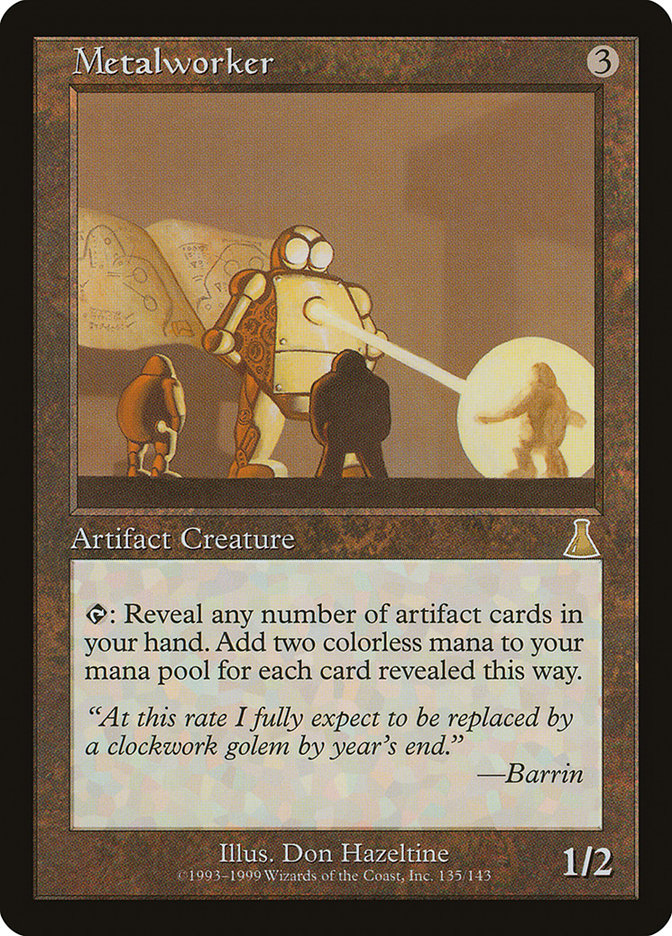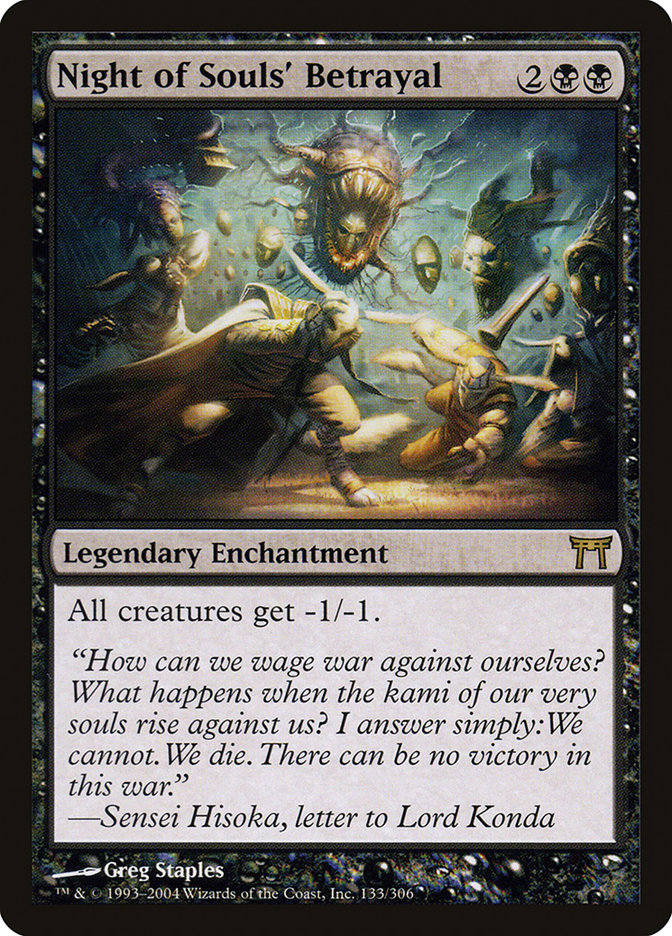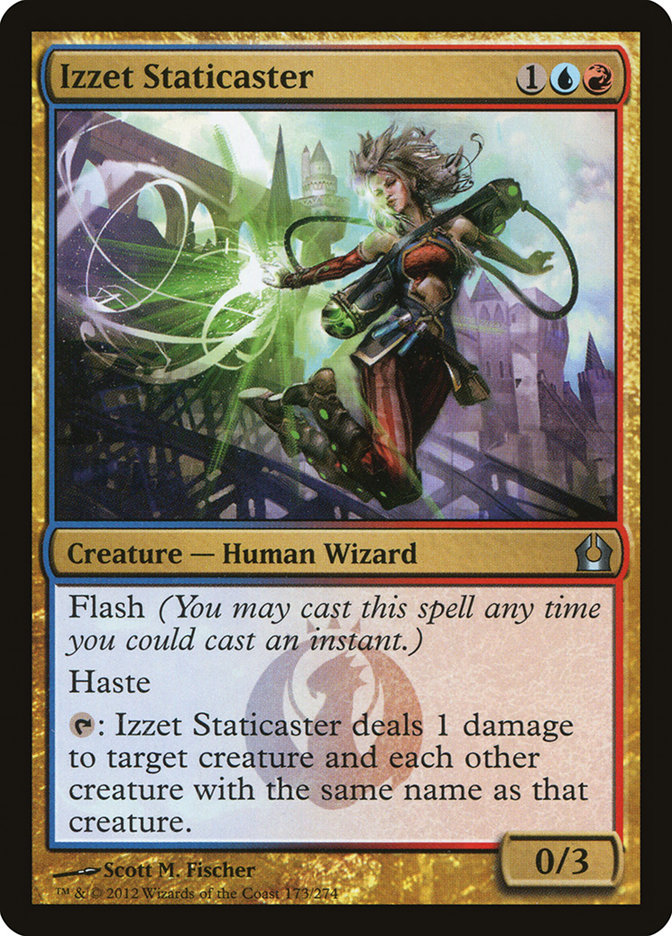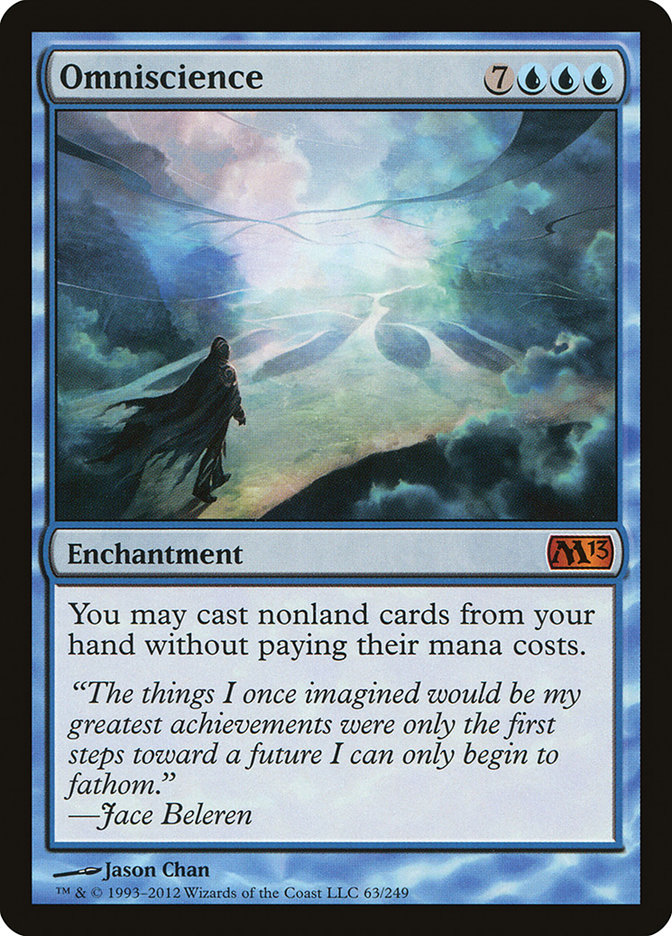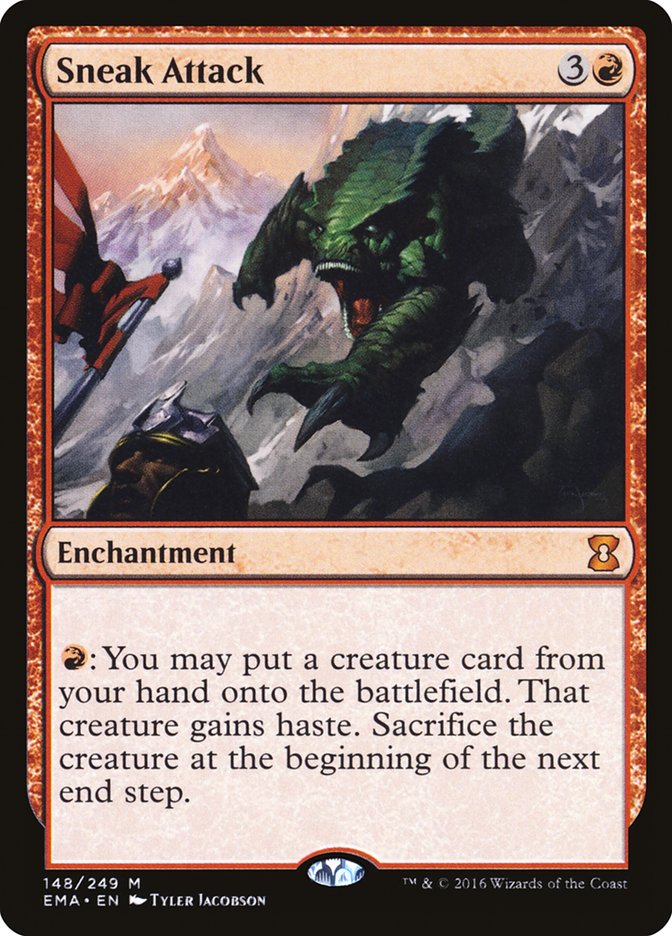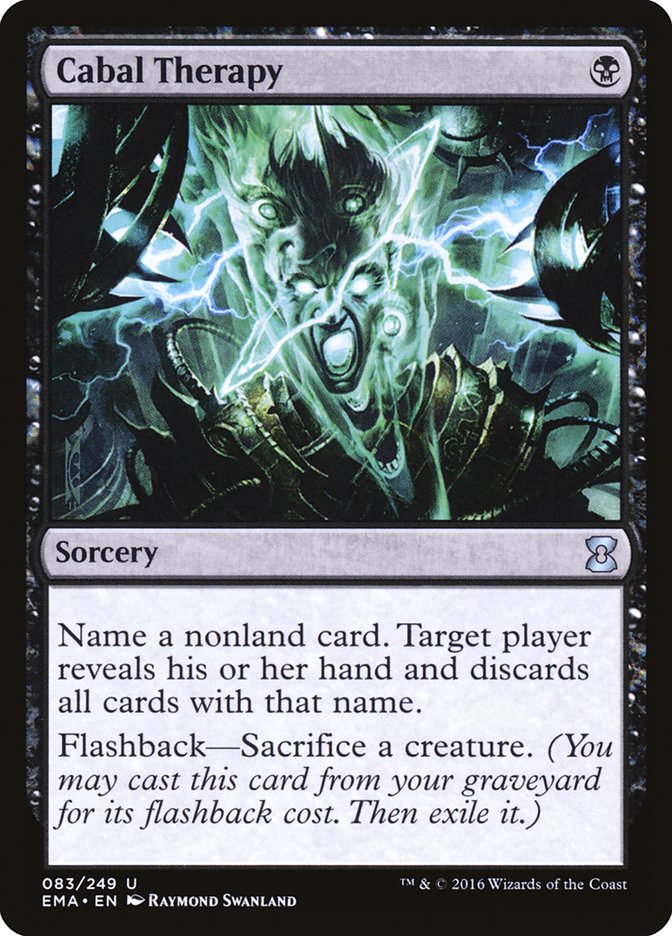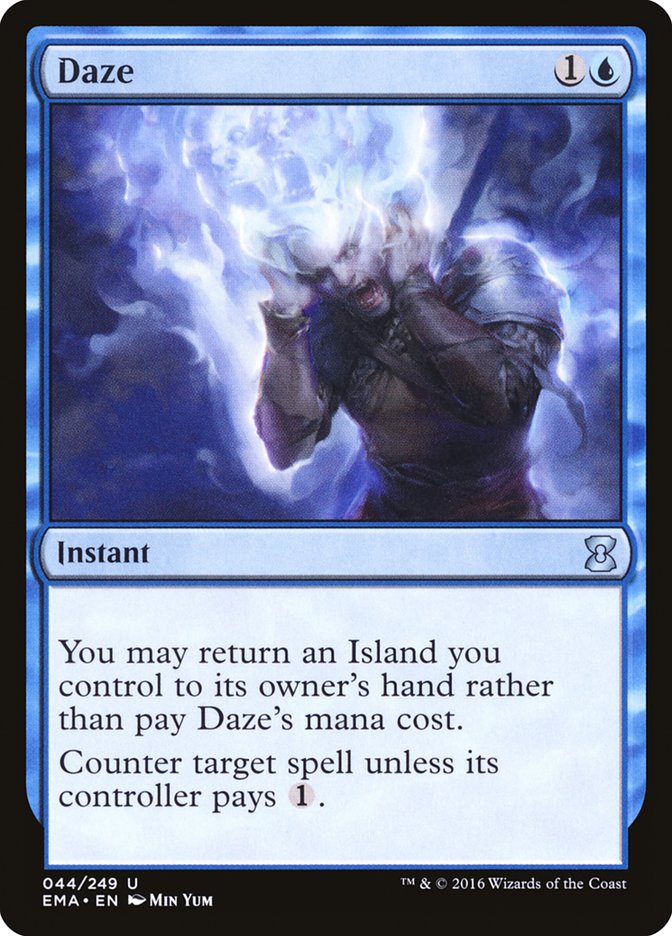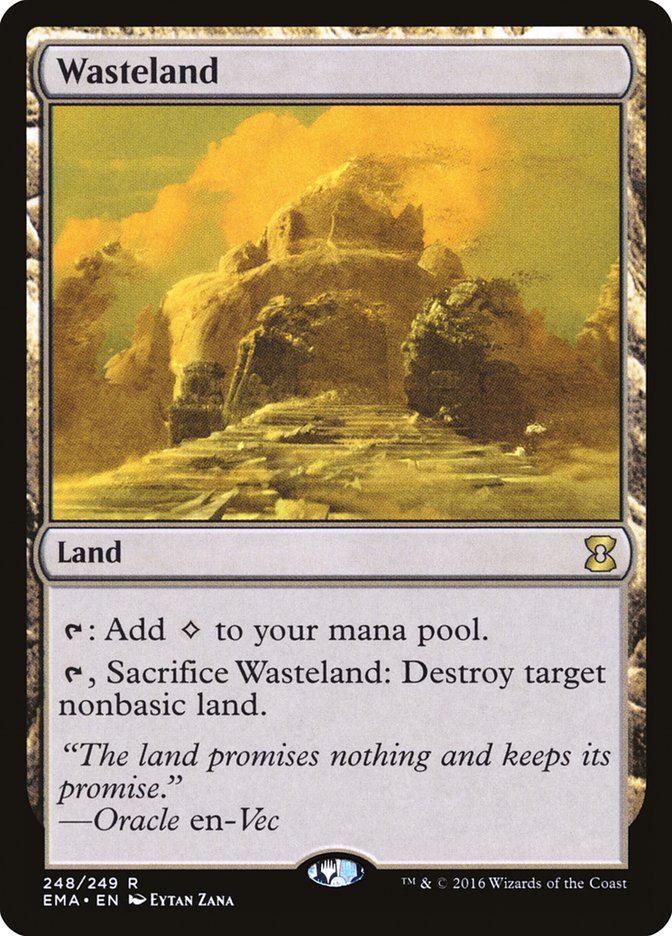It’s been a while since I’ve had the chance to write about Legacy. And honestly, I’m thankful for that. I very much enjoy playing the format, but there is something almost…taboo about writing an article detailing the intricacies of Brainstorm, or discussing a popular matchup. Legacy is a well-guarded format, with hostile defenders ready to take up arms should you fail to mention the original creator of Caw-Terminator or Fruit Loops. And like many of you reading this article, I have no idea what those decks are.
So screw it.
I’ve had a bad month, both in terms of Magic success as well as mental stability. I’ve considered quitting my job and becoming a streamer of some other game. I’ve entertained notions of becoming a professional poker player. I’ve also realized that doing either of those things would be destructive. As much as I get frustrated with the game of Magic, I always come back eventually. I might take a week or month off playing in big tournaments, but deep down I know it is something I love to do. It just takes one stroke of good fortune or one turning point for me to get things back to normal.
And in many of those instances, it is writing an introspective article.
The last article I wrote about my “feelings” was discarded by my editor. It was sloppy, unfocused, and basically a gigantic cry for help. I wanted pity, because I couldn’t find a way to forgive myself. When you start to flail, in your career or in your personal life, things can get out of hand without you realizing it. And quickly, you spiral. But sometimes the only thing you need to do is write it all down, that way you can spotlight the parts you can control, and you fix them. For me, it was a nagging sense of failure, like something stuck between your teeth. Losing in the finals of the SCG Players’ Championship broke me, and it took me months to figure out why.
And even still, I’m unsure I actually got to the root of the problem. Perhaps I just put a Band-Aid on that wound, and it’s starting to fester. Maybe I’m jealous of Jim Davis. Maybe the things happening with my family are starting to wear me down. Maybe I’m going crazy because I just turned 30 years old and have no idea what my future looks like. Or, more likely, it’s all in my head and I just need to shake it off.
Regardless, I hope you understand that this column is special to me. At times, it allows me to vent frustrations with the things that are outside of my control. And at other times, it’s a place where you come to read my thoughts on a deck or format. At the beginning of my career, I treated this column more like a blog than anything, and would write about the “struggles” of becoming a “professional Magic player.” I was young, and foolish, and I regret dragging many of you down with me. For a long time, I wasn’t happy, and I used you as a way to make myself feel better. Sharing sob stories to garner sympathy is wrong, even if writing those thoughts down on paper is cathartic. My personal life and my Magic life are intertwined, and I’ve never been afraid to share my feelings on any subject, but that doesn’t mean I should subject my audience to the skeletons in my closet.
Just know that, from now on, I’ll keep it to a minimum.
Legacy at Grand Prix Columbus
Let me get something out of the way: a lot of Legacy deck names are stupid. Death and Taxes? TPS? Deadguy Ale? Who came up with this garbage? While you may not be inclined to agree with changing these deck names to conform with current Magic nomenclature (Shardless Sultai, Temur Delver, etc.), these names must change if Magic is to grow.
Having names that are like inside jokes to a closed-off community is stifling for newcomers to a format. Why would someone want to buy cards for a Legacy deck if they’re going to get made fun of for not knowing who originally designed it? Maybe all they know is that they saw Caleb Scherer on camera last weekend playing a Storm deck. Coverage called it Storm, so why are you yelling at this kind on the internet for calling it Storm instead of ANT or TPS?
Do you have nothing better to do?
Instead of constantly attacking people over something minor, how about we encourage that person to play a local Legacy event with their Storm deck? Maybe we give them some background knowledge of the archetype, but do so without calling them stupid or using aggressive language? Anyway…
So you remember that Legacy format I was talking about? Well, it has gone through some upheavals over the last few years. With fewer major Legacy events happening on the regular, I haven’t been able to play the format as much as I would have liked. I love Legacy. I really do. But how am I supposed to write about Legacy if I don’t play it as much as I used to? At what point do your beliefs or arguments become invalid? Do I need a minimum number of matches played before you will listen to what I have to say? I’m in the main event instead of the SCG Tour® Classics on Sundays. Or I’m at a Grand Prix. What do I do about that?
Even though Legacy has gone through some tumultuous times, we’re actually at a place where Legacy looks almost like it did with the release of True-Name Nemesis. The only real differences are that a few delve creatures survived the banning of big delve draw spells and there is an Eldrazi deck running around that looks suspicously like a MUD deck (MUD being an artifact-based deck centered around Metalworker…do you see why this name is bad?).
But aside from Eldrazi and Gurmag Angler, most of the Legacy decks we’ve known for some time are still viable, and still seeing play. Maybe a little less Stoneforge Mystic than we remember, but all the major players are still intact. With that in mind, I’m going to go over three powerful decks that I highly recommend for Grand Prix Columbus this weekend.
Creatures (12)
Lands (20)
Spells (28)

Since Tom Ross is busy writing about his most recent win with W/R Humans at the Standard Open at #SCGATL last weekend, I wanted to touch on this archetype because I think it is still a great choice in a wide-open field. Infect preys on people who are unprepared or have very few reps against the archetype. It is a combo deck that plays many games like a Delver deck, forcing the opponent into bad spots. The threat of dying in a single turn puts a lot of pressure on the opponent to navigate the game in a certain way. If you have any history with playing with Infect, you know exactly what I’m talking about.
Unlike Delver, Infect isn’t really trying to attack your resources with Wasteland or Stifle. Mostly, Infect is just trying to find a way to kill you before you take control of the game. But many parts of that plan revolve around getting full value out of cards like Daze or Force of Will. Unlike the Modern version of the deck, Legacy Infect is much more explosive, thanks to Invigorate and Berserk. This is true with many decks ported between Modern and Legacy, but it’s magnified by how powerful Invigorate actually is.
The main problem with Infect in Legacy is similar to that in Modern: removal is a pretty big deal against you, but it isn’t going to end the game by itself. In Modern, you have very little in the way of deck manipulation to find more threats once the opponent has killed the first two or three. This can result in getting flooded with useless pump spells or excess lands while your opponent rules the battlefield.
In Legacy, access to Brainstorm solves a lot of these issues, as you usually have time to dig into more threats while simultaneously filtering away excess lands or pump spells. The Brainstorms out of Infect are much stronger than those in most other blue decks in Legacy, since Infect contains three very distinct card types: creatures, lands, and pump spells. Drawing too many of any of these three card types can result in a loss. Keep that in mind when considering whether or not you should counter your Infect opponent’s Brainstorm.
The pros of Infect are many, which is why Tom and I have been so drawn to the deck for so long. It is…tricky, to say the least. If you are familiar with the matchup, you can beat just about anything, so long as the opponent is not familiar with it. Small interactions, mini-bluffs, and a lot of other minor advantages can be had while playing Infect. It is unlike anything I’ve ever really encountered before in the format. You are the aggressor in every single matchup, putting your opponent to the test even on turns where you don’t have a combo-kill ready. And, my favorite part, you get to be the one that makes them sweat.
The cons of Infect are few, but important to note. If your opponent comes prepared to beat Infect, they can (and often will). Your strategy is vulnerable to a lot of hate cards, and Legacy is chock-full of hate cards. I’m talking Night of Souls’ Betrayal. I’m talking Golgari Charm. I’m even talking Izzet Staticaster.
Yes, these are cards that also see play in Modern sideboards, but when the opponent has other lock pieces like Counterbalance, or their deck is inherently more powerful, sideboard cards will have a much greater impact. This is mostly due to the overall power level of the format. If your opponent is able to put you on the back foot, pressing that advantage is not difficult. And Infect is not a deck that plays well from behind. Of course, you can find ways to win, but it becomes harder as the game progresses and the opponent applies more pressure. Infect creatures are pretty bad at blocking, after all.
While Infect is not for everyone, I do think it is one of the better decks in Legacy, and not one people are sideboarding heavily for at the moment. That makes it a very real threat.
Creatures (8)
Lands (19)
Spells (33)

Sneak and Show is another archetype that hasn’t gotten much press lately and is unlikely to have a lot of hate geared toward it. At one point, it was common to see Oblivion Ring in sideboards or two copies of Karakas in Miracles just to help out against Sneak and Show. Of course, those cards are relevant in other matchups, which is why they saw play, but they were absolutely concessions to one of the most feared decks in Legacy’s history. But over time, people forget about the boogeyman.
I think that this is the perfect weekend for Sneak and Show, and the above list is what I’ll be playing (should I attend). No bells or whistles, just jamming the combo hard and fast. Show and Tell into Griselbrand is still as strong as I remember and still nearly as unbeatable.
Of course, there will be certain strategies that give Sneak and Show a tough time. Those decks have always been around, but those decks can also be beaten. Omniscience solves a lot of problems that hate cards can present. While we only have two total copies in the list, we have enough card filtering to find it should it be necessary.
It is important to note that Sneak and Show was overshadowed for a very long time. People don’t respect Sneak and Show because they haven’t played against it for a while. The reign of Dig Through Time pushed the Sneak Attack versions to the wayside, but that time is gone. While there are certain metagames that can be hostile towards Sneak and Show, I don’t think this is one of them.
The pros of Sneak and Show are several. The combo is easy to assemble. Many combo decks in Legacy bog themselves down and have one particular soft spot for the opponent to attack. Sneak and Show is a bit different, because it invests so little into trying to “go for it.” If you counter the Show and Tell, no big deal. Just find another one, or a Sneak Attack, and try again.
As with most combo decks, an opponent with a significant amount of disruption and a fast clock will be tough to overcome, but that’s basically every combo deck in every format. Sneak and Show will also be able to win games from positions that many other combo decks can’t. You don’t need a large amount of resources to deploy, which means a single Brainstorm can help you combo off as long as you have two cards in hand.
The cons of Sneak and Show are few, but they do exist. Certain combinations, like Phyrexian Revoker and Karakas, can be nearly impossible to beat in the first game. But as you get more experienced with the deck, you’ll understand that as the nature of Legacy. Many Legacy decks are absurdly powerful and have one-two punches that few decks can beat. It is only magnified in combo decks because those decks tend to have no alternate gameplan. There are a lot of hate cards in Legacy that can give you a tough time, but the upside here is that very few of them are seeing play, making Sneak and Show my pick for the tournament.
Creatures (14)
Lands (18)
Spells (28)

Noah has a great mind for the game, and to say I’ve been impressed with his play over the last few months would be an understatement. Grixis Delver has been his archetype of choice for a while now, including the era of Dig Through Time (using it himself, of course). This deck is a bit more aggressive than most Grixis builds I want to try out myself, but I think that’s a good thing. In Legacy, you need to get your opponent dead before they have time to set up, and Delver of Secrets goes a long way in doing that.
While the list in question might seem strange, with only eleven ways to cast a Deathrite Shaman on the first turn, it is important to note that Deathrite Shaman is a fine play on the second or third turn as well. This deck can utilize the extra mana, but also benefits from dealing the opponent damage as the game goes. While Deathrite Shaman on the first turn is obviously great alongside Wasteland and Daze, it isn’t exactly necessary, and Temur Delver decks have been doing the same thing with Nimble Mongoose for years.
I really love the interaction of Young Pyromancer and Cabal Therapy and would recommend trying to fit that combination into most Grixis shells. Hand disruption is key in fighting combo decks that employ discard spells of their own, like Storm, and it gives you a proactive means of interaction. Without Cabal Therapy, Storm opponents have enough time to find the right discard spells to pick your hand apart, leaving you with very little in the way of defense against their big turn.
On the other hand, this deck feels like it’s pulled in multiple directions. It wants to control the opponent’s hand and battlefield but also be aggressive. Playing dual roles in Legacy isn’t always recommended, as it can lead to some tricky situations. Relying too much on control or aggression can be a thin rope, but I think this version of Grixis Delver can do just that if you know how to play the deck. Noah has already proven that the archetype is good enough to see play, given his win over Gerry Thompson at one of the first Legacy Opens featuring the new Eldrazi archetype.
One of the pros of Grixis Delver is that it is a flexible archetype, giving the pilot a lot of breathing room. Since you have two distinct plans of action, Brainstorm can be an incredible card in the archetype, allowing you to filter away excess pieces of removal or threats, depending on the situation. You also have a sideboard that opens up the ability to move toward whatever direction gives you the best potential to win the match. Engineered Explosives and other removal spells are key in defending against Elves or other creature-based decks, while Painful Truths can let you power through grindier matchups like Miracles.
The cons of Grixis Delver include a list of faults that most Delver lists suffer from, inabilities to interact with Counterbalance, kill large creatures, or stop decks that heavily attack your resources while building their own (Lands). While Grixis Delver is a very balanced archetype, it does not mulligan well and needs most of its resources to win. You absolutely need disruptive elements like Daze or Wasteland to be good, or else you’ll end up flooding on non-interactive cards. Brainstorm can’t solve all problems, unfortunately.
…
So that’s it. Those are my big three decks for the weekend. If those aren’t your style, then that’s perfectly reasonable. Much like Modern, Legacy is flush with different decks to choose from, all with their own strengths and weaknesses. I’m just partial to these.
If this is your first time playing Legacy, let me wish you luck. It is a big format. It takes quite some time to get used to all the minor interactions, and even more time to master your deck. In the past, I have spent a lot of time thinking about the format, trying to attack it from a variety of angles, but it seems like these are the three types of decks I keep coming back to. I like to put pressure on my opponents, and these three decks can do just that, and in significantly different ways. If you are a big fan of Legacy, then this weekend should be special for you. There aren’t a lot of Legacy Grand Prix each year, so watching people play the format on a big stage (or playing it yourself) should be a treat.
I know it can be easy to get caught up in the negativity. I’ve succumbed to it myself, if I’m being honest. And perhaps I’m a hypocrite, but at least I’m trying to do something about it. If you find yourself about to put someone down, for whatever reason, think about how you would feel if someone was doing that to you, or saying those things about you.
In actuality, there is a good chance you’re performing that action because it has happened to you. Don’t perpetuate the negative behaviors that have jaded us, and instead welcome newer players to a game or format we all love. After all, if we didn’t like Magic, at least a little bit, we wouldn’t be doing this in the first place. When you’ve left the game, or left this world, what do you want your legacy to be?




